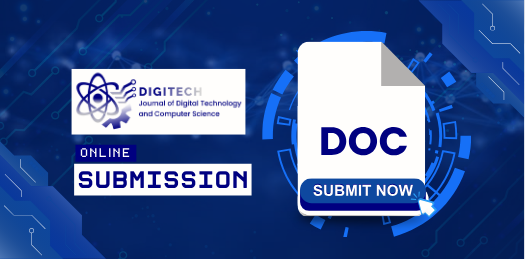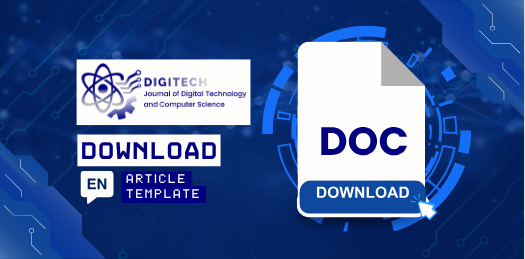Web-Based Tourism Recommendation System for South Sulawesi: Design, Implementation, and Evaluation
DOI:
https://doi.org/10.61220/digitech.v3i1.20255Keywords:
Web Application, Waterfall method, Digital Tourism, Tourism recommendation, Information systemAbstract
Tourism information delivery in South Sulawesi remains constrained by the absence of a digital platform that provides comprehensive and personalized data. Previous studies generally present only basic information without recommendation features that align with user interests. This study develops a web-based application named Sering-Sering, designed to provide both tourism information and personalized recommendations according to user needs. The application was developed using the Waterfall model, a structured and sequential software engineering methodology, and its functionality was evaluated through white-box and black-box testing to ensure completeness and reliability. Results demonstrate that Sering-Sering was successfully implemented through systematic stages of planning, analysis, design, implementation, and testing. The final system is stable, user-friendly, and capable of delivering informative outputs. Black-box testing across 15 scenarios, including login, registration, destination search, profile management, and deletion of favorites and notifications, produced a 100 percent functional success rate. These findings indicate that the application effectively supports tourists in identifying suitable destinations quickly and conveniently while also contributing to regional tourism promotion. Future research is recommended to expand the system by integrating online ticket booking and artificial intelligence-based recommendation features, thereby strengthening its potential contribution to smart tourism development in South Sulawesi.
References
[1] P. J. Cárdenas-García, J. G. Brida, A. Alcalá-Ordóñez, and V. Segarra, “Tourism’s contribution to human development and the reduction of poverty and inequality: Empirical evidence at a regional level in Spain,” International Journal of Tourism Research, vol. 26, no. 4, p. e2669, Jul. 2024, doi: 10.1002/JTR.2669.
[2] M. S. Karimi, H. Karamelikli, and B. Naysary, “The role of tourism in driving economic growth: An asymmetric augmented autoregressive distributed lag analysis of Singapore’s experience,” International Journal of Tourism Research, vol. 26, no. 4, p. e2696, Jul. 2024, doi: 10.1002/JTR.2696.
[3] A. Jariyah, R. Sahabuddin, M. Rakib, and N. Najamuddin, “POTENSI KOTA MAKASSAR SEBAGAI KOTA WISATA KULINER MENUJU MAKASSAR KOTA KREATIF,” Referensi : Jurnal Ilmu Manajemen dan Akuntansi, vol. 12, no. 1, pp. 115–127, Mar. 2024, doi: 10.33366/REF.V12I1.5646.
[4] W. J. Winowatan and J. P. A. W, “POTENSI BUDAYA SUKU TORAJA SEBAGAI DAYA TARIK WISATA PADA KABUPATEN TANA TORAJA DAN TORAJA UTARA,” Tulisan Ilmiah Pariwisata (TULIP), vol. 6, no. 1, pp. 1–8, Jun. 2023, doi: 10.31314/TULIP.6.1.1-8.2023.
[5] S. Firdausy, I. Q. Na’iem, Yusmanizar, and Nasrullah, “STRATEGI KOMUNIKASI DIGITAL BALAI PELESTARIAN CAGAR BUDAYA SULAWESI SELATAN DALAM MENINGKATKAN KUNJUNGAN WISATAWAN, STUDI KASUS: FORT ROTTERDAM,” Jurnal Dakwah Tabligh, vol. 23, no. 2, Dec. 2022, doi: 10.24252/JDT.V23I2.32709.
[6] M. Yusuf, I. Fauziah Amalia, and F. Akbar Zaenal Politeknik Pariwisata Makassar, “Perceptions of Tourism Promotion and Business Challenges in Makassar: A Survey on Digital Marketing Effectiveness for Tourism Businesses,” Social, Humanities, and Educational Studies (SHES): Conference Series, vol. 8, no. 2, Mar. 2025, doi: 10.20961/SHES.V8I2.99322.
[7] B. McKenna, W. Cai, and T. Tuunanen, “Transforming to a Sustainable Visitor Economy With Information Systems,” Information Systems Journal, vol. 35, no. 3, pp. 1079–1092, May 2025, doi: 10.1111/ISJ.12573.
[8] V. Rodrigues, C. Eusébio, and Z. Breda, “Enhancing sustainable development through tourism digitalisation: a systematic literature review,” Information Technology and Tourism, vol. 25, no. 1, pp. 13–45, Mar. 2023, doi: 10.1007/S40558-022-00241-W/METRICS.
[9] S. An, Y. Choi, and C. K. Lee, “Virtual travel experience and destination marketing: Effects of sense and information quality on flow and visit intention,” Journal of Destination Marketing & Management, vol. 19, p. 100492, Mar. 2021, doi: 10.1016/J.JDMM.2020.100492.
[10] T. Gajdošík, “Smart Tourism Destination Governance: Technology and Design-Based Approach,” Smart Tourism Destination Governance: Technology and Design-Based Approach, pp. 1–160, Jan. 2021, doi: 10.4324/9781003269342/SMART-TOURISM-DESTINATION-GOVERNANCE-TOM.
[11] Alfiani, M. Fajar, and F. D. Lestary, “Aplikasi Portal Destinasi Pariwisata Sulawesi Selatan Berbasis Mobile,” Jurnal MediaTIK, vol. 6, no. 3, pp. 102–107, Sep. 2023, doi: 10.59562/MEDIATIK.V6I3.2266.
[12] A. Nurul Izza, D. E. Ratnawati, W. Hayuhardhika, N. Putra, and P. Korespondensi, “Analisis Sentimen Objek Wisata di Provinsi Sulawesi Selatan Berdasarkan Ulasan Pengunjung Menggunakan Metode Random Forest Classifier,” Jurnal Sistem Informasi, Teknologi Informasi, dan Edukasi Sistem Informasi, vol. 3, no. 2, pp. 97–105, Oct. 2022, Accessed: Oct. 02, 2025. [Online]. Available: https://just-si.ub.ac.id/index.php/just-si/article/view/77
[13] N. F. Amran, N. I. Barda, L. R. K. Arafah, and P. A. Syukur, “Sistem Informasi Destinasi Wisata Bulukumba Explore Berbasis Website,” Journal of Security, Computer, Information, Embedded, Network, and Intelligence System, vol. 2, no. 2, pp. 82–94, Aug. 2024, doi: 10.61220/SCIENTIST.V2I2.20244.
[14] M. Ma, A. L. Irwan, I. A. Saputra, and A. Anas, “Analisis Implementasi Electronic Government Melalui Program KAREBA (Karcis Elektronik Kawasan Bira) Dinas Pariwisata Kabupaten Bulukumba,” Contemporary Public Administration Review, vol. 2, no. 1, pp. 33–46, Aug. 2024, doi: 10.26593/COPAR.V2I1.8300.33-46.
[15] X. Wang, X. Wang, and I. K. W. Lai, “The effects of online tourism information quality on conative destination image: The mediating role of resonance,” Front Psychol, vol. 14, p. 1140519, Mar. 2023, doi: 10.3389/FPSYG.2023.1140519/BIBTEX.
[16] M. A. Garcia-Haro, M. P. Martinez-Ruiz, R. Martinez-Cañas, and P. Ruiz-Palomino, “Benefits of Online Sources of Information in the Tourism Sector: The Key Role of Motivation to Co-Create,” Journal of Theoretical and Applied Electronic Commerce Research 2021, Vol. 16, Pages 2051-2072, vol. 16, no. 6, pp. 2051–2072, Aug. 2021, doi: 10.3390/JTAER16060115.
[17] A. Mishra and Y. I. Alzoubi, “Structured software development versus agile software development: a comparative analysis,” International Journal of System Assurance Engineering and Management, vol. 14, no. 4, pp. 1504–1522, Aug. 2023, doi: 10.1007/S13198-023-01958-5/FIGURES/4.
[18] Eric. Verzuh, “The fast forward MBA in project management : the comprehensive, easy-to-read handbook for beginners and pros,” vol. 6, p. 522, 2021.
[19] “ISO/IEC 25010:2023,” Geneva, Switzerland, 2023. [Online]. Available: https://www.iso.org/standard/85765.html
[20] M. C. Saputra, S. A. Wicaksono, S. H. Wijoyo, P. N. Rahmandita, and B. T. Hanggara, “Quality Analysis of an Interactive Programming Learning Platform Based on ISO/IEC 25010 Using a String-Matching Approach on User Reviews,” J-INTECH, vol. 13, no. 01, pp. 192–202, Jul. 2025, doi: 10.32664/J-INTECH.V13I01.2003.
[21] J. Wang, Z. Xu, X. Wang, and J. Lu, “A Comparative Research on Usability and User Experience of User Interface Design Software,” International Journal of Advanced Computer Science and Applications, vol. 13, no. 8, pp. 21–29, Aug. 2022, doi: 10.14569/IJACSA.2022.0130804.
[22] Ł. Radlí, A. Jarz˛ Ebowicz, W. Wysocki, T. Kanoutas, T. Karanikiotis, and A. L. Symeonidis, “Enhancing Code Readability through Automated Consistent Formatting,” Electronics 2024, Vol. 13, Page 2073, vol. 13, no. 11, p. 2073, May 2024, doi: 10.3390/ELECTRONICS13112073.
[23] C. Wibowo, T. Wijanarko, and A. Putra, “Utilizing phpMyAdmin for System Design in Enterprise Administration,” Journal of Technology Informatics and Engineering, vol. 3, no. 2, pp. 217–234, Aug. 2024, doi: 10.51903/JTIE.V3I2.193.
[24] O. Kharisman, G. Pramuwidyanti, A. Makmur, and A. Tri Dharma Palu, “Desain dan Implementasi Sistem Informasi Pariwisata Berbasis Web pada Dinas Pemuda Olahraga dan Pariwisata Kabupaten Buol,” Jurnal Kewarganegaraan, vol. 6, no. 3, pp. 5792–5801, Oct. 2022, doi: 10.31316/JK.V6I3.4077.
[25] M. Y. P. Bagau and H. P. Chernovita, “PERANCANGAN SISTEM INFORMASI GEOGRAFIS PARIWISATA DAN RUTE ANGKUTAN UMUM BERBASIS WEB PADA DINAS KEBUDAYAAN DAN PARIWISATA KOTA SALATIGA,” Sebatik, vol. 25, no. 2, pp. 632–638, Dec. 2021, doi: 10.46984/SEBATIK.V25I2.1177.
[26] Idris, “Sistem Informasi Pariwisata Berbasis Website di Dinas Pariwisata Kabupaten Donggala,” Jurnal MediaTIK, vol. 5, no. 2, pp. 17–21, Jun. 2022, doi: 10.59562/MEDIATIK.V5I2.2973.
[27] N. A. Ersa, N. A. Matondang, and S. Afrizal, “Sistem Informasi Pariwisata Berbasis Web Pada Kabupaten Nunukan,” JIPI (Jurnal Ilmiah Penelitian dan Pembelajaran Informatika), vol. 7, no. 2, pp. 478–486, May 2022, doi: 10.29100/JIPI.V7I2.2822.
Downloads
Published
Issue
Section
License
Copyright (c) 2025 Reza Fathurrahman, Dwi Putri Nadila, Nurfahmi Hidayat, Hairin Ahmad Khairul Shiddiq, Ahmad Khairul Shiddiq (Author)

This work is licensed under a Creative Commons Attribution 4.0 International License.








 Email:
Email: 
